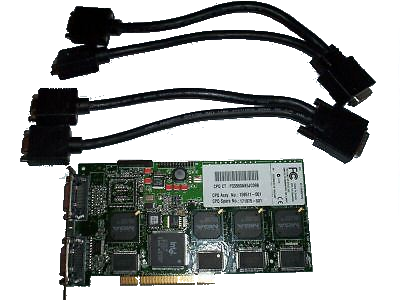Matrox Millennium G200 / G250
The Millennium G200 used Matrox' brand new chipset in 1998, surpassing all the original Millennium 1164 and 2164 chips with a full suite of hardware 3D acceleration features.
 |
Released | 1998 |
| Bus | AGP 1x v1.0 (3.3V only) | |
| Chipset | MGA-G200 (G200A D2) | |
| Standards | Hercules, CGA, EGA, VGA | |
| Memory | G200: 8 MB SGRAM (upgradable to 16 MB) G250: 16 MB SGRAM |
|
| Ports | 15-pin DSUB (G200 only) DVI out (G200 Quad only) 26-pin VGA Feature connector SODIMM memory expansion slot |
|
| RAMDAC | 250 MHz | |
| Part # | MGI-G2-DUALP-PL, MGA-G200A (G200/G200 Quad) 5064-9191 (G250) |
|
| FCC ID | - | |
| Price | Jul 1999: $68 (8 MB) | |
| See Also | Millennium II, Mystique G200, Millennium G400 |
G200 was Matrox’s first fully AGP-compliant graphics processor. While the earlier Millennium II featured AGP, it did not support the full AGP feature set. The G200 took advantage of DIME (Direct Memory Execute) to speed texture transfers to and from main system RAM. That allowed the G200 to use system RAM as texture storage if the board's local RAM was of insufficient size for the task at hand. G200 was one of the first cards to support this feature.
It came with an excellent 2D core, something that Matrox were famous for. The 3D core was not as fast as 3dfx Voodoo2, but in most cases it offered a significantly better image quality. 32-bit color rendering and a 32 bit Z-buffer are the ones responsible for that besides a lot of other nice features.
It's core clock ran at 85 MHz.
The key thing that caused potential G200 buyers to instead plum for an nVidia RiVA TNT or 3dfx Voodoo3 was the Matrox card's lack of OpenGL support. Matrox promised this was coming, but failure to have this ready at launch was enough to cause the G200 to flop. OpenGL support was critical in these days, as every 3D game was using it. Matrox was trying to please both the business user and the hard core gamer, which turned out to be a mistake.
While the Millennium G200 was the higher-end version equipped with 8 MB SGRAM, the Mystique G200 used slower SDRAM but added a TV-out port. Sadly the G200s were released just shortly before a new generation of cards were launched by ATI and nVidia (RIVA TNT), which both completely outperformed the G200 range.
Matrox also released a Millennium G200 Quad, supporting up to four displays simultaneously. This card is a "dual-head" card but using the provided cables you could display on four separate monitors. The MGA-G200 graphics chip could support 2 or 4 analog or digital outputs per single PCI board. With several of these cards, you can display up to 16 monitors from a single system! Maximum resolution per channel was 1920 x 1200 @ 16bpp @ 70 Hz, 1600 x 1200 @ 24bpp @ 85 Hz or 1280 x 1024 with digital flat panel monitors.
For Windows, the G200 Quad uses G200 MMS drivers supported under Windows® XP, Windows® 2000, Windows® Me, Windows® NT®4.0, and Windows® 98. Minimum system requirements are PCI bus motherboard, Pentium 133+ with 32 MB RAM, Windows 98, XP, 2000 or NT 4.0.
A Millennium G250 was also released in 1998. This came with either 8 or 16 MB of SGRAM. The 8 MB version could be expanded to 16 MB using the SODIMM memory slot. This card was OEM'd to Compaq (part #358231-005) - the memory expansion slot was removed and it came with 8 MB onboard memory only.
Board Revisions
I have no board revision information for the G200.
Competition
In the Media
Integrated Solution - The G200 offers both 2D and 3D acceleration. Matrox has almost always provided the fastest 2D cards on the market and the G200 raises the bar once again.
Good Performance - Direct3D tests we've seen put it on par with Voodoo 2. OpenGL tests remain to be seen.
Decent Price - Boards should cost as little as $150 in 8MB configurations.
Excellent Image Quality
Cons
Matrox has a rocky track record; the Mystique suffered from very poor 3D performance.
On The Horizon
There is current no information regarding Matrox's next generation of chips."
PC Accelerator, Issue 1 September 1998
Unlike most other vendors here, Matrox offers an array of add-ons - TV tuner ($150), DVD decoder ($80), video-editing daughterboard ($80), and digital flat-panel connector ($50) - so you can change the Millennium as your needs evolve. The more expensive Marvel includes an integrated TV tuner and TV-out capabilities, and it accepts most of the same options as the Millennium. A slick external cable box for the tuner eliminates the need to hunt behind the PC when attaching a digital camera, VCR, camcorder, or cable TV lead. We found the Marvel's on-monitor TV quality fine; the color was well saturated and the picture almost as sharp as a dedicated TV set. The tuner is controlled via a virtual remote control with easy access to picture adjustments.
Both cards share a common installation routine and most driver features. We had no problems setting up either one, and Matrox's interface offers a robust array of controls for customizing monitor settings and the Windows desktop. The Marvel has additional controls for its multimedia tools, plus a setup utility that walks you through configuring and testing the video ports and cabling. The manuals are clear, and there's quick-start guide for setting up the Marvel's more elaborate cabling.
When it comes to 3-D performance, the Matrox chip is a step behind the newer offerings from nVidia and 3Dfx. Results were in the middle of the pack. The chip also registered some minor quality flaws involving certain MIP-mapping, texture rasterization, and geometry rasterization features. But our test games played without any discernible artifacts or jittery screens, and games seemed particularly vivid - possibly enhanced by Matrox's new Vibrant Color Quality (VCQ) technique. The 2-D test scores were better, negligibly behind those of the leaders, and the Video Bandwidth results (an indicator of signal quality) were among the best we've measured.
The Marvel's software bundle is excellent, and includes Ulead Photo Express 2.0, Ubi Soft's Tonic Trouble, and a trial version of VDO-Phone Internet Trial. In addition, the bundle includes the new Avid Cinema video editing software, a joint effort between Avid and Matrox.
Generally, the Marvel and Millennium are stocked with features and software well suited for their intended markets. For the price, we wish the Marvel delivered better 3-D performance. For business users interested in a solid 2-D card with good enough 3-D and room to grow, the Millennium is an excellent choice."
PC Magazine, 1st December 1998
Setting it Up
I have no information on configuring the G200.
Downloads
User Manual Original Matrox user manual. |
Original Utility Disk Get in touch if you can provide this missing item! |
Video BIOS ROM Get in touch if you can provide this missing item!
|
More Pictures

A Millennium G200 Quad with cables to support up to four monitors

A Millennium G250, expanded to the full 16 MB